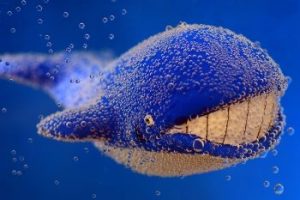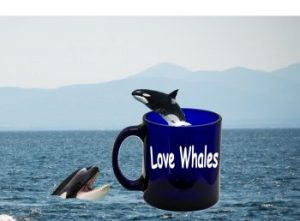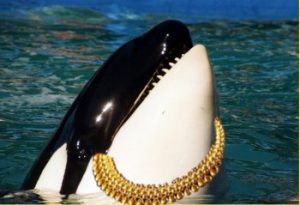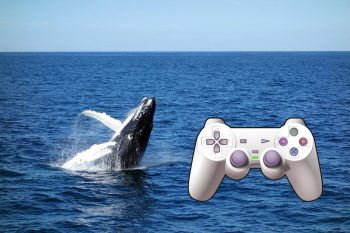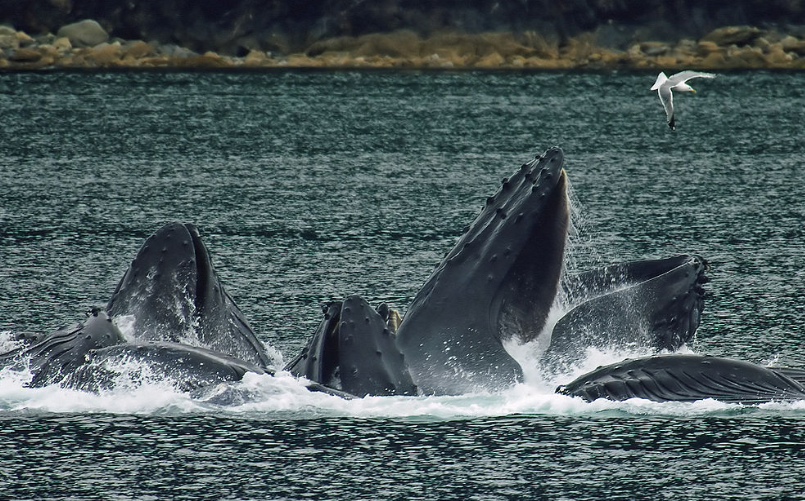
After watching a movie about whales, I was very curious about the life of the whales and customs. Those giant monsters that cross the oceans.
Where to start? As I looked at my plate of food, that question arose in my mind. What do whales eat ?? I started looking for information and found very interesting things.
The baby whales.
When they are born to be mammals moms feed their babies milk from mammary glands. There are many photos and footage of this moment. It really is very sweet. Whale mothers take care of their babies for a decade and keep them away from the older ones.
But how much milk does a baby whale take?
A few species of whale (such as the blue whale) may drink in excess of 150 gallons of milk per day and can easily gain 100 pounds or more each day in its first few months of birth primarily from drinking its mother’s milk. This surprised me … but after thinking about that, I remembered that these animals is marine giants`s babies … it weigh tons … it really have to drink a lot of milk !!!
During the first seven months of its life, a blue whale drinks approximately 380 liters (100 US gallons) of milk per day. Blue whale calves gain weight quickly, up to 90 kilograms (200 lbs) every 24 hours. Even at birth, they weigh up to 2,700 kilograms (5,950 lb), the same as a fully grown hippopotamus.
But about to the feeding of whales, adults, they are divided into 2 different groups. Did you know?? I do not until recently …
These are: toothed whales and baleen whales. The name itself already gives an idea what it refers to. The toothed whales have teeth that they use to hunt and eat, and the baleen whales have beards in place of teeth. That makes the diet of each one different. At least in the size of their prey.
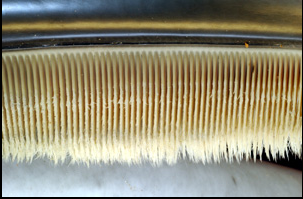
These are the bristles in the mouth that help the whales to trap small fish, krill and plankton.
What do the Baleen Whales feed on?
To understand better, let’s examine how Baleen whales feed. This mammals use a filter-feeder system inside the mouths. The baleen system works by a whale opening its mouth underwater and taking in water. The whale then pushes the water out, and animals such as krill are filtered by the baleen and remain as food source for the whale.
On one side of the plates are coarse bristles. These bristles vary in length and thickness, but they all help the whales to trap small fish, krill and plankton. Most species prefer the colder waters of the Arctic and Antarctic.
Some of the most well-known species of baleen whales are:
What do Blue whales eat?
Blue whale the largest known animal to have ever existed. This whale speciesprimarily eat krill although other small creatures such as copepods can be ingested as well. It can consume as many as 40 million krill per day, which ends up weighing close to 8,000 pounds of food on a daily basis!
Gray whale
Gray whale primarily eat krill, small bait fish larvae, shrimp and herring. But they are specialized for feeding on bottom-dwelling crustaceans.
What do Humpback whales eat?
Humpback whales are known for eating a variety of small fish, krill, salmon, herring, mackerel and capelin.

Credit: Evadb; Edit by jjron. [Public domain]
This species has the most diverse food repertoire of all mysticetes. His way of catching his prey is peculiar. The technique is known as “bubble net”, in which a group of individuals swims in concentric circles releasing bubbles through the spiracles under the schools of fish. The bubble ring surrounds the school of fish, closing progressively, gathering them in an increasingly smaller cylinder. Then, they suddenly jump on them taking a big bite and swallowing thousands of fish in one gulp. The slotted plates in the animal’s mouth allow it to easily drain all the water taken in the maneuver. The ring formed by the bubbles can be up to thirty meters in diameter and requires the cooperation of a dozen animals.
Bowhead whales
Bowhead whales the typical diet contains small prey such as plankton, krill, copepods and mysids (tiny crustaceans).
Minke whales
Minke whales The smallest and has up to 70 slots in the area of the throat, this helps them in the process of collecting water and materials in it, to then be able to filter the food. Minke whales are known for eating small fish, krill, copepods, cod, herring, capelin, and pollock among other small sea creatures.
North Atlantic right whale
North Atlantic right whale feeds by swimming forward with its mouth open, filtering through its beards, so it specializes in much smaller prey, such as eat zooplankton and krill.
Southern right whales
Southern right whales the primary diet consists of copepods, krill, mysids and plankton among other tiny crustaceans.
What do toothed whales eat?
Toothed whales are known to be active hunters and can sometimes eat larger forms of prey than baleen whales. Wow!!! That really is awesome!
Let’s see about the feeding of the most known species.
Killer whales
The Killer whales for example hunt in well-organized groups, as a family. These mammals are known to eat a large variety of foods such as fish, squid, sea lions, walruses, seals, sharks and even large whales. I always felt sorry to see the images of that hunt. But it is part of the balance of nature. In addition, they only hunt for food and not for fun. It’s very interesting that they are also extremely social and relationships that develop between killer whales can last a lifetime.
Sperm Whale
The Sperm Whale or cachalot (the largest of the toothed whales) typically prefers a diet containing octopus, large squid and some fish. These whales are able to dive over 3,000 feet underwater and can remain submerged for over an hour when hunting for prey. When observed up close circular marks can be found on and around the whale’s head from confrontations with octopus and large squid latching onto its head in an attempt to keep from being eaten.
When compared to the social structure of killer whales, sperm whales live solitary lives often allowing their pods to travel alone or move to other small pods. But they are very protective of each other. Unfortunately, not much is known about how sperm whales hunt calamari due to deep diving excursions that make it difficult for marine scientists and biologists to effectively study their hunting methods. These marine monsters submerge up to 3,000 feet underwater, which makes it difficult for human accompaniment to do so and study it.
Beluga whales
Beluga whales are opportunistic feeders. They eat octopus; squid; crabs; snails; sandworms; and fishes such as capelin, cod, herring, smelt, and flounder. The belugas, those very white whales feed on or near the bottom of shallow water. Observers suggest that belugas can produce suction and a strong jet of water with their mouths that can pull the prey out of the bottom. And even though they have teeth, beluga whales do not chew their food; they swallow it whole.
Pilot whale
Pilot whale Its diet includes squid, octopus, herring and various small fish. They tend to prefer squid, this being their primary source of food if it is available. They can eat about 30 pounds of food a day, which is very little compared to other types of whales of their size.It work in groups when it comes to hunting their food. Using a kind of high-pitched whistle, they create a circle that seems to hypnotize the prey that they can then consume easily.
As we could see, some get their food on the surface and others in very deep places of the ocean. These last mentioned are fed without breathing !!!! It’s amazing !!! This becomes possible because its do not breathe with the mouth, as other mammals.
Let’s see something else about whale breathing
They are mammals and not fish, they need to come to the surface to breathe. They breathe air through nostrils, called spiracles. And not by mouth, as we mentioned. These spiracles are on the top of the head and the amount varies between the toothed whales and baleen whales. The toothed whales have one spiracle while the baleen whales have two.
And how it works?
Once the whales have caught the air from the surface they can continue to swim and submerge, some manage to be from 20 minutes to two hours containing this breath.
How do they hold so much time underwater?
Their ability to hold their breath for so long is because the whales are able to process the air they take from the surface, because they use 90% of the oxygen that has entered their lungs. After this, they return to the surface to expel from their body the water vapor along with mucus that has formed in their lungs. What gives first impression the appearance of being a water jet.
This is one of the most attractive shows for people who visit places to see them. As well as his acrobatic jumps.
What places can we visit to have an experience as exciting as those of seeing such marine monsters so close?
Why do they jump?
How do whales communicate ?
How fast can a whale swim ???
What is the second largest whale in the world?
These and other topics we will consider in other articles ….
You may also like…
There is a wide variety of available stuffed whales and plush whales like stuffed humpback whales, plush orcas, plush blue whales or stuffed belugas. Kids of all ages like to have them and to play with these friendly aquatic animals.
Visit this gallery of the awesome whale mugs selection of ofwhale.com. That allows you to find how to drink tea, coffee, milk or what you want with your preferred friends the whale. They can be natural life whale mug, whale-shaped coffee mugs, narwhal mug or even dolphin mug. Only for whale lovers.
Here you will find a variety of delicate necklaces with charms of whales or whale tails for you to use in an infinity of occasions and to be very elegant or to surprise a friend, girlfriend, mother or another woman that you have affection.
Download educational and entertaining whale games and realistic whale simulators for child, teenagers and all ages. Enjoy learning or playing with the best nature games people prefer. If you love whales and the ocean this is the place to begin your entertainment.

